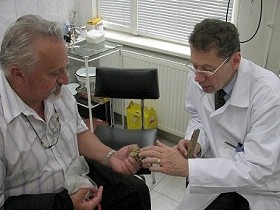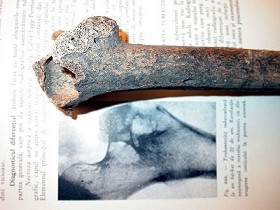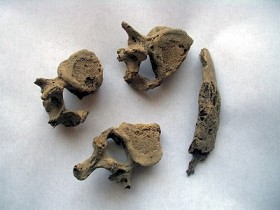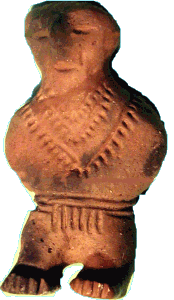
In literature the bones are supposed to belong to an adult man who is in general considered to be a priest, a shaman or a high dignitary on the basis of the associated artefacts and the cremation ritual designed for a very special person. Nevertheless the anthropometric analysis that the Prehistory Knowledge Project asked to the Centre for Anthropological Research of Romanian Academy of Science at Iasi ascertained that the bones belong to a female, very ill and very old for the standards of that times. Let us try to outline an identikit of "Milady Tărtăria" on the basis of the anthropometric analysis made at Iasi by Georgeta Miu. Sex and age. The skull and pelvis are missing (from the latter there are only some fragments), so that sex and age determination of the subject has some limitations. Based on metric and morphological features of the long bones (entire or fragmentary) and others (collar bone, vertebras, talus, heel bones, and fragments of the belt bones from pelvis area) we consider that she is a female of 50-55 years old. The age was estimated based on: resorption of the spongy tissue, the aspect of the pubic area and some particular pathological degenerative processes of some bones. The height. The height is 147 cm, indicative of a small woman. It was calculated on the basis of classical known methods (radius, cubitus and tibia length).  The anthropological type. Our analysis and conclusions are based on the small height of the subject and on the gracile features of the bones. I remind that skull and face bones are missing. Based on the available data we believe that all this features indicate the Mediterranean type. Paleopathologic aspects. A degenerative process of the bones has been identified on the right femur (the cervix and the head of the femur). This degenerative-arthritis process contributes to the modification of the diaphysis aspect (the bone is thicker and shorter) and have caused an anchylose for the femoral articulation.  It is possible to observe the same degenerative process on three dorsal vertebras (maybe 6th, 7th, and 8th): the body of the vertebras is half than a normal one in size because of the destruction of the tissue (on the right side). This kind of malformation did not cause neurological lesions. It is possible that this degenerative process affected also the ribs related to these vertebras (some fragments show this process). The lower part of the articular surfaces of the pubis shows a similar destruction process. We do not know the origin of these bone lesions, but they are associated with a quite high process of osteoporosis. All these degenerative processes may have produced great pain and it is probable that the pain must have been a commonplace experience for Milady Tărtăria for the last 10-15 years of her life. But her death can be related to other reasons.  According to the anthropometric analysis of the Centre for Anthropological Research of Romanian Academy of Science at Iasi, the osteoporosis degenerative process wasn't the `silent epidemic' that typically affects post-menopausal women and involves loss of bone mass, but could have been due to the pyogenic osteomyelitis (bone inflammation) or to the Mycobacterium tuberculosis (osteo-arthritis tuberculosis) or to the Treponema pallidum (syphilis). According to the anthropometric analysis of the Centre for Anthropological Research of Romanian Academy of Science at Iasi, the osteoporosis degenerative process wasn't the `silent epidemic' that typically affects post-menopausal women and involves loss of bone mass, but could have been due to the pyogenic osteomyelitis (bone inflammation) or to the Mycobacterium tuberculosis (osteo-arthritis tuberculosis) or to the Treponema pallidum (syphilis). Osteomyelitis is the most common kind of pathology seen in ancient skeletons and it is usually the result of infections of microorganisms that produce pus. Also tuberculosis is a very ancient disease. The bacillus (Mycobacterium) probably predates the genus Homo. The earliest evidence in Europe is in Germany, where a young male (5,000 BC) was discovered with the 3rd and 4th thoracic vertebrae found collapsed. [15] Regarding syphilis, endemic or non-venereal syphilis (treponematosis or what is commonly refereed to as bejel) and venereal syphilis are not the same diseases. In the case of both, skeletal involvement is extensive and ultimately fatal; however, their mode of transmission is quite different. The venereal form of the illness is transmitted by sexual contact, while the non-venereal from of it is transmitted by skin contact, occurring mostly in childhood. [16] The origin of syphilis is an ongoing debate, but early evidence of it was revealed by a Italian burial [17] and a Polish one. [18] Even though pyogenic osteomyelitis, tuberculosis and syphilis behave differently, [19] the symptoms of each are quite similar and they affected Lady Tărtăria since her youth. The posture. Milady Tărtăria limped on her right leg since her youth because of her thicker, anchylosed and shorter right femur and leg. She had a posture forming a > (an arrow) because of the degenerated, decalcified and fragile spine. She had also the tendency to angle towards the right because a scoliosis had deformed the right side of her chest and her right shoulder. There is a not very well known figurine found at Turdaş that can give an idea of the Milady Tărtăria.  | |
Merlini Tărtăria | 1 | 2 | 3 | 4 | 5 | 6 | 7 | 8 | 9 | 10 | 11 | 12 | 13 | 14 | 15 | |